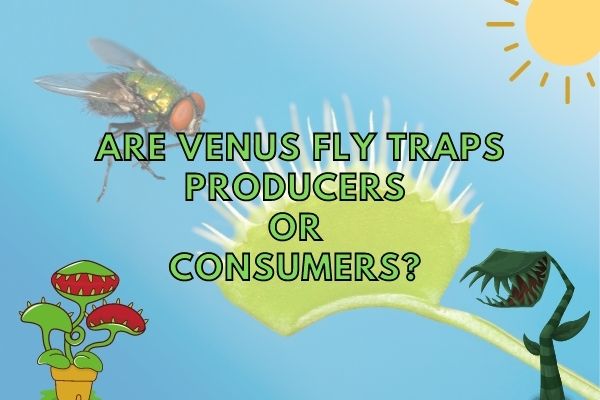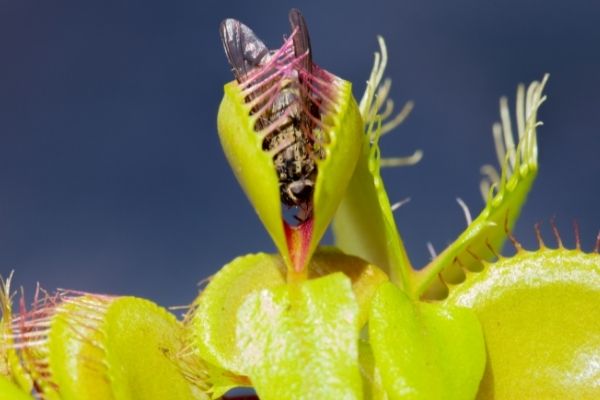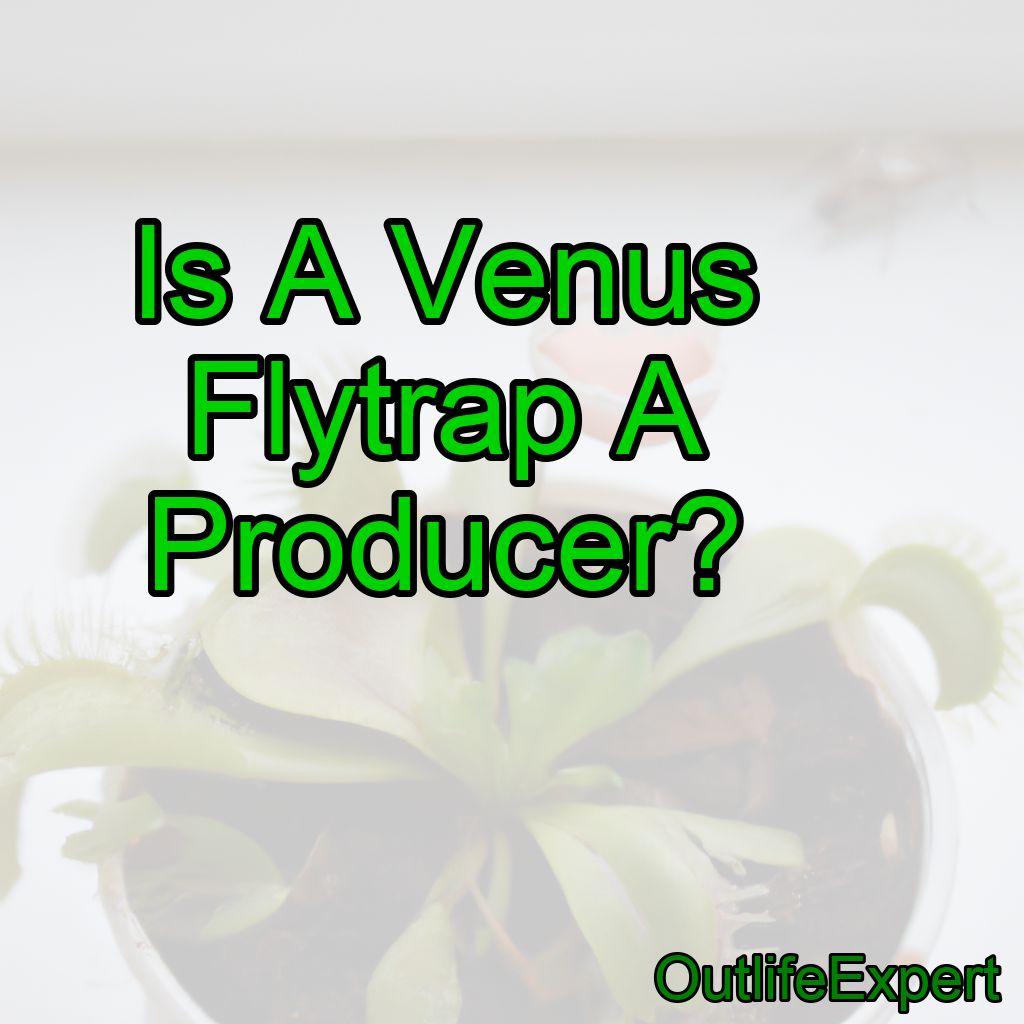In short, no, a Venus Flytrap is not a producer. The Venus Flytrap is a unique and fascinating plant that defies traditional classifications.
While it is a plant and does photosynthesize, it also consumes insects and other small animals as part of its nutrition.
This combination of characteristics makes it difficult to classify the Venus Flytrap as strictly a producer. In this blog post, we will explore the various aspects of the Venus Flytrap, how it captures and consumes its prey, and its role in the ecosystem.
Contents
Why Is A Venus Flytrap A Producer and not a Consumer?
As a biologist with experience in the field, I can confidently explain why a Venus flytrap (Dionaea muscipula) is classified as a producer rather than a consumer. The classification of organisms into these categories is based on their primary source of nutrition and their position in the food chain.
To understand why a Venus flytrap is considered a producer, we need to delve into its unique biological characteristics. The Venus flytrap is a carnivorous plant that primarily grows in nutrient-poor environments, such as bogs and wetlands. It has evolved specialized leaves with trap-like structures that can capture and digest small insects. These leaves contain specialized cells known as trigger hairs that are sensitive to touch.
When an unsuspecting insect brushes against these trigger hairs, a complex series of events is set in motion. The Venus flytrap rapidly snaps its leaves shut, entrapping the insect within its grasp. The trap then secretes a mixture of digestive enzymes that break down the insect’s tissues, releasing nutrients that the plant can absorb.

While it may seem counterintuitive, the Venus flytrap’s carnivorous nature does not make it a consumer. Instead, it is still classified as a producer because it is ultimately obtaining its energy from photosynthesis. Like other plants, the Venus flytrap has chlorophyll-containing cells in its leaves that enable it to harness energy from sunlight and convert it into chemical energy through photosynthesis. This process involves the absorption of carbon dioxide from the air and the conversion of light energy into chemical energy, which is stored in the form of glucose.
The glucose produced during photosynthesis serves as the primary source of energy for the Venus flytrap. It is used to fuel various metabolic processes, including the growth and development of the plant, the maintenance of cellular functions, and the production of new trap leaves. The nutrients obtained from the digestion of captured insects, such as nitrogen and minerals, are used as supplementary resources to support the plant’s growth and reproductive processes.
In essence, the Venus flytrap is not solely reliant on consuming insects for its survival. Instead, it primarily relies on the process of photosynthesis to produce its own energy, making it a producer. The ability to capture and digest small insects is an adaptive strategy that allows the Venus flytrap to thrive in nutrient-poor environments by supplementing its nutrient requirements.
Having studied these fascinating plants extensively, I have had the opportunity to witness firsthand the remarkable adaptations of the Venus flytrap. It is truly a marvel of nature, demonstrating the intricate ways in which organisms can adapt to their surroundings to ensure their survival. By understanding its classification as a producer, we gain a deeper appreciation for the complexity and diversity of life on our planet.
What is a Venus Flytrap?
Description and Distribution
The Venus Flytrap Dionaea muscipula is a small, carnivorous plant that is native to the subtropical wetlands of the southeastern United States, particularly in North and South Carolina. It is a unique plant due to its ability to catch and digest insects and other small animals for nutrition. The Venus Flytrap has a distinct appearance, with its green leaves forming a rosette and the trapping mechanism consisting of two hinged lobes edged with trigger hairs.
Role in the Ecosystem
In its natural habitat, the Venus Flytrap plays a crucial role as both a consumer and a producer. While it does produce its own food through photosynthesis like other plants, it also consumes insects and other small animals to supplement its diet. This dual role helps maintain a balance in the ecosystem by controlling insect populations and providing nutrients to the soil through the decomposition of its prey.
How Does a Venus Flytrap Work?
The Trap Mechanism
The Venus Flytrap’s trapping mechanism is a wonder of evolution. Each trap consists of two lobes, hinged together and lined with trigger hairs. When an insect or other small animal comes into contact with the hairs, the trap snaps shut, trapping the prey inside. The lobes then produce a digestive enzyme that breaks down the animal’s soft tissues, allowing the plant to absorb the nutrients.

Nutrient Absorption
The Venus Flytrap requires specific nutrients that are not readily available in the nutrient-poor soil of its native habitat. By consuming insects and other small animals, the plant is able to obtain essential nutrients such as nitrogen, phosphorus, and potassium. These nutrients are absorbed through the plant’s digestive process and are used to support its growth and development.
What Does a Venus Flytrap Eat?
Diet
The Venus Flytrap’s diet primarily consists of insects, spiders, and other small invertebrates. However, it has been known to occasionally consume small vertebrates like frogs and even small mammals if they are small enough to fit within the trap. The plant is not picky about its prey, as long as it provides the necessary nutrients.
Prey Attraction
The Venus Flytrap does not actively hunt for its prey. Instead, it relies on the bright coloration of its traps and the sweet nectar produced by the glands on the inner surface of the lobes to attract insects and other small animals. Once an unsuspecting creature lands on the trap and brushes against the trigger hairs, the trapping process begins.
How to Care for a Venus Flytrap
Soil and Water Requirements
Venus Flytraps require nutrient-poor, acidic soil to thrive. A mixture of peat moss and perlite or sand is ideal. They also need a constant supply of water, as they naturally grow in wetland environments. It is essential to use distilled water or rainwater, as tap water may contain minerals that can harm the plant.
Light and Temperature
Venus Flytraps require plenty of sunlight to perform photosynthesis. Ideally, they should receive at least 4 to 6 hours of direct sunlight each day. If grown indoors, a fluorescent light or grow light can be used to provide the necessary light exposure. The plant prefers temperatures between 70°F and 95°F during the growing season and requires a winter dormancy period with cooler temperatures between 35°F and 50°F.
Common Misconceptions About Venus Flytraps
They Are Man-Eating Plants
Venus Flytraps are not man-eating plants, and they pose no threat to humans. They are small plants that consume insects and other small animals, not large mammals. This misconception likely stems from popular culture depictions of gigantic, carnivorous plants in movies and literature.
They Require a Constant Supply of Insects
While Venus Flytraps do consume insects and other small animals as part of their diet, they do not require a constant supply of prey. In fact, they can survive for extended periods without capturing any prey, relying solely on photosynthesis for their nutritional needs. However, they will not grow as quickly or be as healthy without the additional nutrients provided by their carnivorous diet.
Venus Flytrap Conservation
Threats to the Venus Flytrap
The Venus Flytrap is currently listed as a vulnerable species, with its population declining due to habitat loss, poaching, and the illegal collection of wild plants for the horticultural trade. Additionally, climate change and the resulting shifts in weather patterns and ecosystems may also pose a threat to the survival of this unique plant.
Conservation Efforts
Efforts are being made to protect the Venus Flytrap and its habitat through the establishment of nature reserves, the enforcement of laws against poaching and illegal collection, and the promotion of responsible cultivation practices among horticulturists and hobbyists.
In conclusion, the Venus Flytrap is not a producer, but rather a unique plant that occupies a dual role as both a producer and a consumer in its ecosystem.
This fascinating plant is an important part of its native wetland habitats and requires our continued efforts to ensure its survival. Here are ten quick facts about the Venus Flytrap to remember:
1. The Venus Flytrap is acarnivorous plant.
2. It is native to thesoutheastern United States.
3. The plant uses atrapping mechanismto catch its prey.
4. It consumes insects and other small animals foressential nutrients.
5. The Venus Flytrapdoes photosynthesizelike other plants.
6. It requiresspecific soil, water, and light conditionsto thrive.
7. The plant isnot dangerous to humans.
8. It is listed as avulnerable species.
9. The Venus Flytrap is threatened by habitat loss, poaching, and illegal collection.
10. Conservation efforts are underway to protect this unique and fascinating plant.
FAQs
What is the Venus flytrap food chain?
The Venus flytrap is a carnivorous plant that feeds on insects, making it the top predator in its food chain.
Is a pitcher plant a producer or consumer?
A pitcher plant is a producer as it is a photosynthetic organism that produces its own food through photosynthesis.
Are Venus fly traps considered omnivores?
Yes, Venus fly traps are considered omnivores because they derive some of their nutrients from insects and other small prey, in addition to photosynthesis.
Why are Venus flytraps not animals?
Venus flytraps are not animals because they are plants. Although they are carnivorous and can trap and digest insects, they do not have the key characteristics of animals such as the ability to move independently, consume food through a digestive system, and respond to stimuli in a complex manner.
Are carnivorous plants producers or consumers?
Carnivorous plants are both producers and consumers. They produce their own food through photosynthesis, but also consume insects and other small organisms for additional nutrients.
Is Venus flytrap a consumer or producer?
Venus flytrap is a consumer, as it obtains its energy by consuming insects and other small animals.




